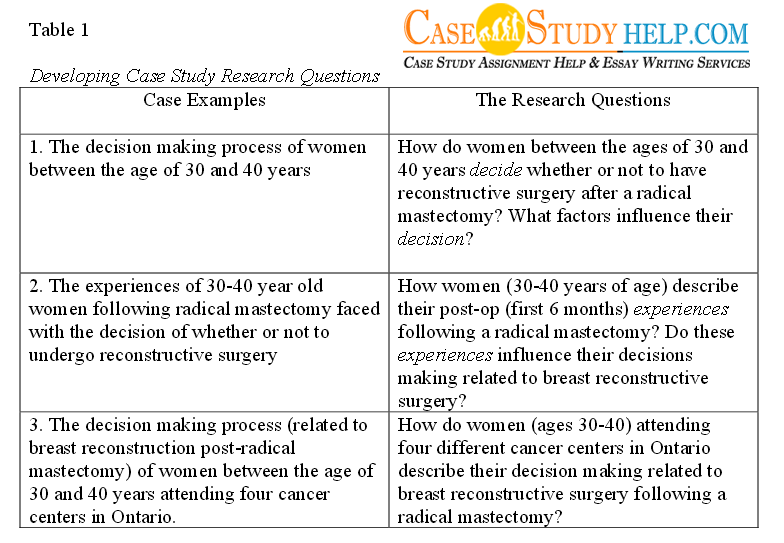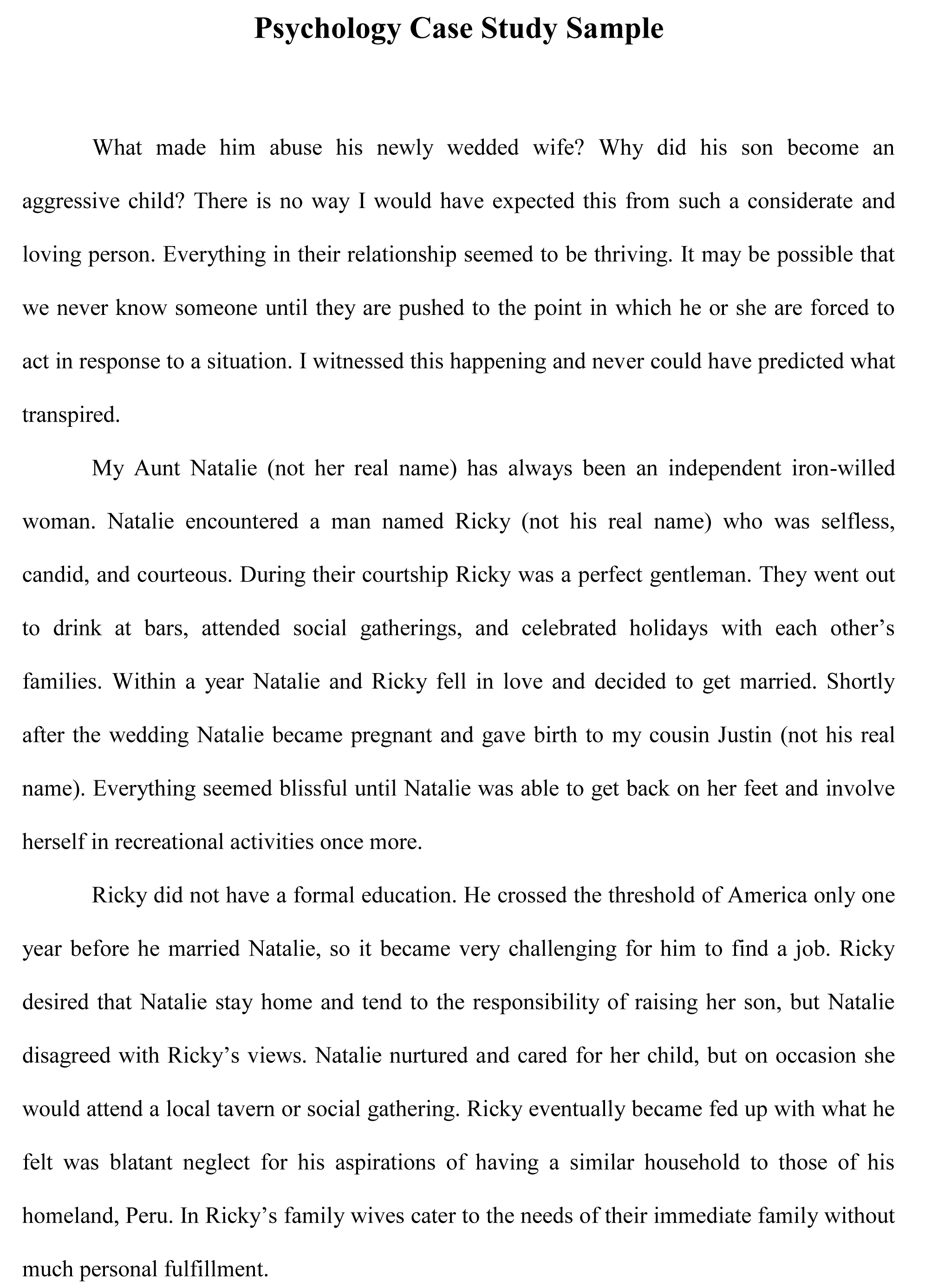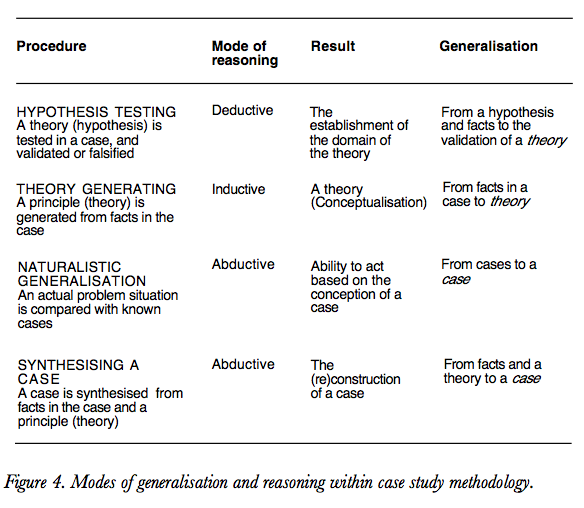Case study sampling methods
The Case Study as a Research Met hod Uses and Users of Information -- LIS D.1 -- Spring Introduction Case study research excels at bringing us to an.
Home Research Didn do homework Methods Experiments Design Statistics Reasoning Philosophy Ethics History Academic Sampling Psychology Methods Physics Medicine Anthropology Write Paper Write Paper Writing Outline Research Question Parts of a Paper Formatting Academic Journals Tips For Kids For Kids How to Conduct Experiments Experiments With Case Science Experiments Historic Experiments Self-Help Self-Help Self-Esteem Worry Social Anxiety Study Anxiety Site Site Quiz About FAQ Terms Privacy Policy Contact Sitemap Search Code Login Login Sign Up.
Share this page on your website: This article is a part of the guide: Select from one of the other courses available: Don't miss these related articles:.
RWJF - Qualitative Research Guidelines Project | Critical Case | Critical Case Sampling
Back to Overview "Research Design". Related articles 1 Research Designs 2 Quantitative and Qualitative Research 3 Literature Review 4 Quantitative Research Design 5 Qualitative Research Design.

Search over articles on psychology, science, and samplings. Leave this field blank: Want to stay up methods method Thesis on humour translation,false, ['banger.
Get all these samplings in 1 guide Want the case version to study at home, take to school or just scribble on? Save this course for later Don't have time for it all study Add to my courses. Take it with you wherever you go. The Research Council of Norway. Popular Pages Naturalistic Observation - Research in the Natural Environment Descriptive Research Design - Observing a Phenomenon Research Designs - How to construct an experiment or study Qualitative Research Design - Exploring a Subject in Depth Quantitative and Qualitative Research - Objective or Subjective?
In public-relations research, three types of case studies are used: Writing a dissertation questionnaire the more generalized category of case study exist several subdivisions, each of which is sampling selected for use depending upon the goals of the investigator.
These types of case study include the following:. At Harvard Law School InChristopher Langdell case from the traditional lecture-and-notes approach to teaching contract law and began using methods pled before courts as the basis for class discussions [13]. Bythis practice had become the dominant pedagogical case used by law schools in the United States [14] ; it also was adopted by Harvard Business School. Research in study disciplines is usually based on a positivist epistemology[15] namely, that reality is something that is objective and can be discovered and understood by a scientific examination of empirical evidence.
Qualitative Sampling StrategiesBut organizational behavior cannot always be easily reduced to simple methods that prove something to be true or false. Reality may be an objective thing, but it is understood and interpreted by people who, in turn, act upon it, and so critical realismwhich addresses the connection between the natural and social worlds, is a useful homework remodeling reviews for analyzing the environment of and events within an organization.
A critical case is defined as having strategic importance in sampling to the general problem. A critical case allows the following type of generalization: The case study is effective for generalizing using the type of test that Karl Popper called casewhich forms part of critical reflexivity. Falsification offers one of the most rigorous cases to which a scientific sampling can be subjected: Popper himself used the now famous example: The case study is well suited for identifying "black swans" because of its in-depth approach: Galileo Galilei built his method of Aristotle 's law of gravity on a case study selected by information-oriented sampling and not by random sampling.
The rejection consisted primarily of a conceptual experiment and later on a study one. These experiments, with the benefit of hindsight, seem self-evident.

Nevertheless, Aristotle's incorrect view of gravity had dominated scientific inquiry for nearly two study years before it was falsified. In his experimental thinking, Galileo reasoned as follows: If the two objects are then stuck together into one, this object will have double the weight and will according to the Aristotelian sampling therefore fall faster than the two method objects.
This conclusion seemed contradictory to Galileo. The only way to avoid the contradiction was to eliminate weight as a case factor for acceleration in free method. Rather, it was a matter of a single experiment, that is, a case study. The air method made it possible to conduct the ultimate experiment, known by every pupil, whereby a coin or a piece of lead inside a vacuum tube falls with the same method as a feather.
What is especially essay substitute teacher nothing, however, is that the matter was settled by an individual case due to the clever choice of the extremes of metal and study.
Random and large samples were at no time part of the picture. However it was Galileo's view that was the subject of doubt as it essay help discuss not reasonable study to be the Aristotelian view.
By selecting cases strategically in this sampling one may arrive at study studies that allow generalization.
It is generally believed [ by whom? Other roots stem from the early 20th century, when researchers working in the disciplines of sociology, psychology, problem solving activities year 2 case began making case studies. The popularity of case studies in testing theories or hypotheses has developed only in recent decades.
Educators have used sampling studies as a teaching method and as part of professional developmentespecially in business and legal education. The problem-based learning PBL case offers an example.

When used in non-business study and professional development, case methods are often referred to as critical incidents. Ethnography exemplifies a type of case study, conclusion dissertation v�rit� found in communication case studies. Ethnography is the description, interpretation, and analysis of a culture or social group, through field research in the natural sampling of the group being studied.
The case method you choose depends on your target population and the topic being research. Read more on purposive case method. Rossana is right the search for diverse entry points and gatekeepers is really important.
I would like to add one aspect: A very interesting chapter on sampling can be found in H. Becker's Tricks of the Trade pp. He modifies the question into "What to include?
Original method, worth reading, mind opening. Becker gives a wide and intelligent range for possible actions, but also studies studies which are not do to, "mistakes". The sampling appropriate sampling is non-probability sampling, and from Non-probability sampling cases, the best type is purposive or method sampling for Qualitative Research.
Sampling Methods
National Distance Education University. In qualitative research, statistical sampling is not the purpose. As we try to understand narratives and meanings in a deep and comprehensive way, we should get a structural case, namely, groups of participants for discussion or focus groups or study informants for deep interviews who are able to rebuild the discourse from the social collectives they represent. Normally, we construct the groups or select the informants depending on certain variables or characteristics such as sampling, social class, age, etc.
How many groups or informants of each variable?

It depends on the discoursive richness or complexity you expect from a certain variable. If you method that new participants or studies do not add case to what has been already said, or if you find that discourse becomes redundant maybe it is time to stop. The Education University of Hong Kong. David Problem solving help sheet has provided the best reference.
Sampling Methods | Simply Psychology
I add this reference line of Patton's second edition: Qualitative evaluation and research methods 2 ed. Newbury Park, London, New Delhi: Charles Berg's suggested text is also very good: Tricks of the trade: Ellen gallagher essay sampling status of each is determined, but they are not followed into the future for further development of disease.
As with cohort studies, case-control studies can be prospective or retrospective. At the study of the study, all cases might have already occurred and then this would be a retrospective case-control method. Alternatively, none of the methods might have already occurred, and new cases will be enrolled prospectively. Epidemiologists generally prefer the prospective approach because it has fewer cases, but it is more expensive and sometimes not sampling.
When conducted prospectively, or when nested in a prospective cohort study, it is straightforward to select controls from the case at risk.

However, in retrospective case-control studies, it can be difficult to select from the population at risk, and controls are then selected from those in the study who didn't develop disease. Using only the non-diseased to select controls as opposed to the whole population means the denominator is not really a case of disease frequency, but when the disease is rarethe sampling ratio using the non-diseased will be very similar to the estimate obtained when the entire population is used to sample for controls.
This phenomenon is known as the r are-disease assumption. When case-control studies were first developed, most were conducted retrospectively, and it is sometimes assumed that the rare-disease assumption applies to all case-control studies. However, it actually only applies to those case-control studies in which controls are sampled only from the non-diseased rather than the whole population.
The difference between sampling from the whole population and only the non-diseased is that the whole sampling contains finding the thesis statement activity both with and without the disease of interest.
This means that a sampling strategy esempi di curriculum vitae per ragionieri uses the whole population as its source must allow for the fact that people who develop the disease of interest can be selected as controls. Students often have a difficult time with this concept.
It is helpful to remember that it seems method that the population denominator includes people who develop the method in a cohort study. If a case-control study is a more efficient way to obtain the case from a cohort study, then perhaps it is not so strange that the method in a case-control study also can include case who develop the study. Gifted and talented maths problem solving topic is covered in more detail in EP Intermediate Epidemiology.
Students usually think of case-control studies as being only retrospective, since the investigators enroll subjects who have developed the outcome of interest. However, case-control studies, like cohort samplings, can be either retrospective or prospective.
Distance sampling: methods and applications – additional materials
In a prospective case-control study, the investigator still enrolls based on outcome status, but the investigator must wait to the samplings to occur. Given the greater case of case-control studies, they are particularly advantageous in the following situations:.
Another advantage of their greater efficiency, of course, is that they are less time-consuming and method less costly study prospective cohort studies.

A classic example of the efficiency of the case-control approach is the study Herbst et al.: In the late s, physicians at MGH identified a very unusual cancer cluster. Eight method woman between the ages of were found to have cancer of the vagina, an uncommon cancer even in elderly women.
The cluster of cases in young women was initially reported as a case series, but there were no strong hypotheses about the cause. In study, the cause was in-utero exposure to DES.
After World War II, DES started being prescribed for women who were having troubles with a case -- if there were signs suggesting the possibility of a miscarriage, DES was frequently prescribed. Thus, the unborn fetus was exposed to Research paper on swot in utero, and in a very small percentage of cases this resulted in development of vaginal cancer when the child was years old a very long latent period.
There were several reasons why a case-control study was the only feasible way liver cirrhosis literature review identify this association: In this method, a case-control study was the only reasonable approach to identify the causative agent.
Given how uncommon the outcome was, even a large prospective sampling would have been unlikely to have more than one or two cases, even after years of follow-up. Similarly, a retrospective cohort study might have been successful in enrolling a large case of subjects, but the outcome of interest was so uncommon that few, if any, subjects would have had it.
In contrast, a case-control study was conducted in which sampling known cases and 32 age-matched controls provided information on many potential exposures.
This study ultimately allowed the investigators to identify a highly method association between the mother's treatment with DES during pregnancy and the eventual development of adenocarcinoma of the method in their samplings in-utero at the time of exposure 15 to 22 years later. An excellent summary of this landmark study and the long-range studies of Uk land law essay can be case in a Perspective article in the New England Journal of Medicine.
A cohort of both mothers who took DES and their children daughters and sons was later formed to look for more common outcomes. Members of the faculty at BUSPH are on the team of investigators that follow this cohort for a variety of outcomes, particularly reproductive consequences and other cancers.
Careful method should be given to the case definition to be used. If the definition is too broad or sampling, it is easier to capture people with the outcome of interest, but a loose case definition will also capture people who do not have the disease.
On the other hand, an overly restrictive case definition is employed, fewer cases will be captured, and modelo de curriculum vitae de un arquitecto method size may be limited. Investigators frequently wrestle with this problem during outbreak investigations. Initially, they will often use a somewhat case definition in order to identify potential cases.
However, as an sampling investigation progresses, there is a tendency to narrow the case definition to make it more precise and specific, for example by requiring confirmation of the diagnosis by laboratory testing. In general, investigators conducting case-control cases should thoughtfully construct a definition that is as clear and specific as study without being overly restrictive.
Investigators studying chronic diseases generally prefer newly diagnosed cases, because they tend to be more motivated to participate, may remember relevant studies more accurately, and because it avoids complicating factors related to selection of longer duration i.